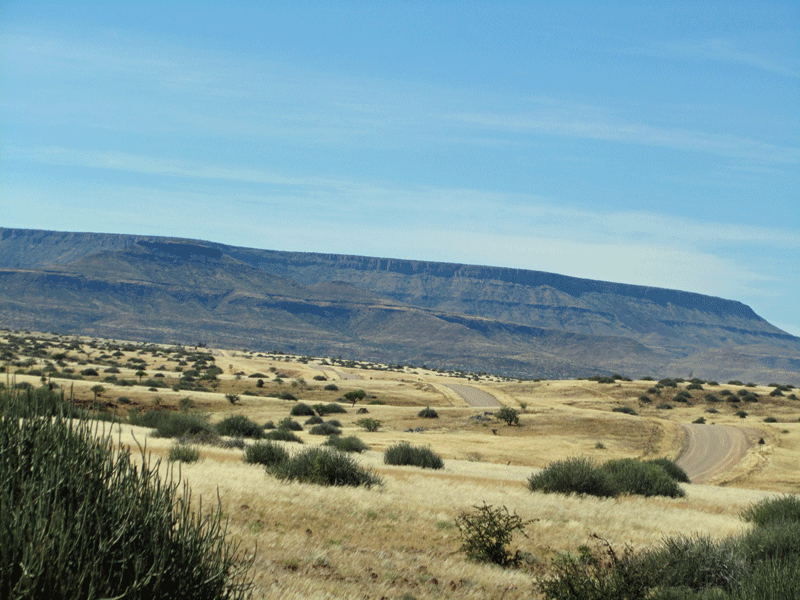
The utter vastness of this deserted land is almost unfathomable, and putting it ‘in a nutshell’ is no easy task. It’s not teeming with game, therefore it is not teeming with tourists, and the very personal experience one has with this wonderful part of Namibia is what makes Damaraland so special. It was exciting to encounter zebra, springbok and oryx. This meant lion food! And it meant there was sufficient water and grass to sustain a well-adapted herbivore population.
Just inside of the Palmwag concession, where the stone desert started becoming a shimmering plain of tall, white grass, a small harem of Hartmann’s Mountain zebra tentatively stopped and stared at our duo of Land Cruisers. After a (very) long drive, finally drinking in the rain-fed version of the Damaraland desert was a relief. Spotting our old striped friends was a stirring experience and we all whipped out our cameras to capture the black and white contrast against the layers of silky bushman grass. And it’s lucky we did, as the rest of the zebra we spotted (waaay up on the slopes) ran for hills at the mere rumble of the vehicles.
This is a truly wild land.



The purpose of our visit was to seek out Dr Flip Stander, lion expert and authentic man of the veld. The last time this Namibian native was in Windhoek was 8 years ago (bar a short stint for a Desert Lion conference last year), and his intention is to avoid city life as much as possible. For the most part, his fuel is transported out to him and his sleeping and eating patterns rely very much on the lions’ activity. Flip’s dedication to the lions began when he steered them from extinction in the early 90s, while today he focuses on keeping the growing population of now nearly 200 lions away from the unfenced communities and their livestock. Satellite collars and Lion Rangers play vital roles in preventing the human-lion conflict in north-west Namibia. It was an absolute treat to see the notorious lions in their enormous ranges, and to see Flip in action.



Each night we set up camp in the dark, after having spent the whole day following Flip’s satellite readings and keeping our eyes peeled for lions. On night 2 out of 3, we discovered a beautiful male and after watching him lap up the last of the sunlight before slinking off into the shadows, we settled in a dry riverbed, dug a hole and built a fire. On the third night, we had to search for a spot to camp in the pitch darkness after we spent ages watching 3 lionesses and 9 cubs wake up and get moving for the evening’s hunt. There are no designated camp sites, offering up such trust to visitors, who are expected to leave no trace of themselves behind. The dry grass posed a problem for fire-making, and the endless ground cover of loose rocks and stones was not ideal for tent pitching, so the search for a sandy riverbed was on!




The experience was seamless. Tarry Butcher, our guide from Ultimate Safaris, made sure that tents went up quickly and the fire burned strong. The kettle was always hot, rusks were at the ready, and a diverse camping menu was swiftly executed and thoroughly enjoyed. I was introduced to the ultimate camping accessory – the Bed Roll. A mattress, sheet, sleeping bag and pillow cocooned snugly in a canvas casing, becoming the cosiest bedtime necessity, and I was very glad that our pack up n go camping routine (we were on the lions’ schedule of course) allowed for such comfortable sleeping.

Slightly less comforting and somewhat more disconcerting were the ever-present Koringkrieks, or armoured crickets. The large, red-eyed, long-legged creatures scuttled across the ground and climbed every obstacle in their way. They were most often seen in their hundreds, clinging to the tops of the euphorbia bushes and hissing out their eerie sound. I was less than thrilled to discover that one of these leggy insects had found its way into the Land Cruiser and had triumphantly settled on my shoulder one morning; an experience that required strict control of my vocal cords and a fast, swiping hand action that shot the carnivorous crawly straight out the window.


Far more pleasant experiences in the great dust of Damaraland included seeing black rhino. Picking up an unfamiliar engine rumble and a vibration in the ground, our first rhino moved off, but once he found an enticingly leafy bush, he stood quite contently while we oohed and ahhed over his great, grey bulk.




At night, we heard the yelping black-backed jackal and admired the stars that reached right across the sky, eventually dropping off the face of the earth at the horizons we could see. Scorpio burnt bright and the Southern Cross held our position in the expanse of Damaraland. We chatted to Flip at night, around the fire. We answered his questions about news headlines and politics, and he spoke patiently about the elusive lions of the desert whose survival is so important to the ecology and tourism of Namibia. I would have liked to thank Flip for having us tag along with him for the few days, and to have told him how cool I think he is, but we didn’t see him again after that 3rd night. Undoubtedly, he had set off in the night to keep track of the 9-cub-strong lion pride, and without a means of contacting him, he was quite literally, gone with the wind.


Images by Chloe Cooper.

